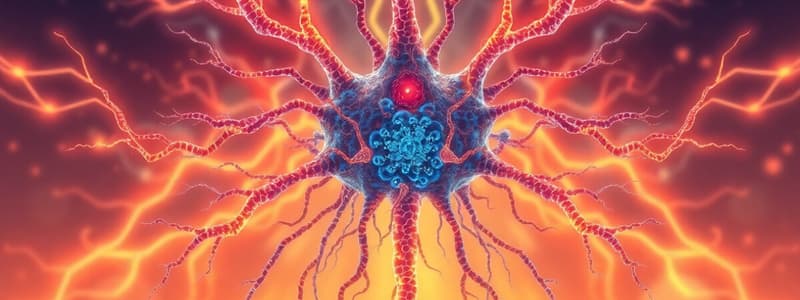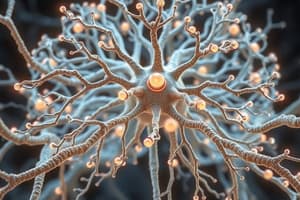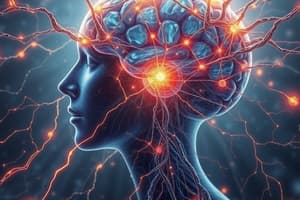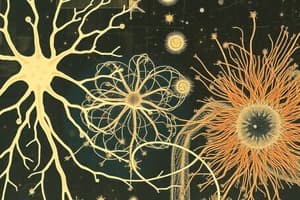Podcast
Questions and Answers
What is one reason biological psychologists study animals in research?
What is one reason biological psychologists study animals in research?
- Animal behavior is not relevant to human behavior.
- Legal restrictions allow animal studies without ethical guidelines.
- Only humans display complex behaviors.
- Mechanisms of behavior are similar across species. (correct)
Which statement best describes the 'minimalist' approach to animal research?
Which statement best describes the 'minimalist' approach to animal research?
- It promotes research without any ethical considerations.
- It focuses on reduction, replacement, and refinement of animal use. (correct)
- It suggests that animal research is irrelevant to human studies.
- It advocates for the complete elimination of animal research.
What should be understood about the structural components of a neuron?
What should be understood about the structural components of a neuron?
- The structure of neurons is crucial for their function within the nervous system. (correct)
- Neurons solely transmit electrical signals without supporting functions.
- Neurons are anatomically identical to other body cells.
- Neurons do not consist of different structural components.
Which of the following is NOT a main division of the nervous system?
Which of the following is NOT a main division of the nervous system?
Which function is primarily associated with the structures of the brain?
Which function is primarily associated with the structures of the brain?
What is the primary function of sensory neurons?
What is the primary function of sensory neurons?
Which type of glial cell helps synchronize the activity of axons?
Which type of glial cell helps synchronize the activity of axons?
What is grey matter primarily composed of?
What is grey matter primarily composed of?
Which of the following is NOT a function of microglia?
Which of the following is NOT a function of microglia?
What structure in the nervous system is responsible for reflex actions?
What structure in the nervous system is responsible for reflex actions?
What do oligodendrocytes and Schwann cells have in common?
What do oligodendrocytes and Schwann cells have in common?
During embryonic development, which glial cells are primarily involved in guiding neuron migration?
During embryonic development, which glial cells are primarily involved in guiding neuron migration?
Which component of the nervous system carries signals to and from the brain?
Which component of the nervous system carries signals to and from the brain?
What is the primary function of dendrites in a neuron?
What is the primary function of dendrites in a neuron?
What role do myelin sheaths play in neuronal function?
What role do myelin sheaths play in neuronal function?
What distinguishes an axon from a dendrite?
What distinguishes an axon from a dendrite?
What part of the neuron releases neurotransmitters?
What part of the neuron releases neurotransmitters?
Which type of neuron conducts impulses from the central nervous system to muscles?
Which type of neuron conducts impulses from the central nervous system to muscles?
What is a key difference between presynaptic and postsynaptic neurons?
What is a key difference between presynaptic and postsynaptic neurons?
What is a common feature of dendritic spines?
What is a common feature of dendritic spines?
What are nodes of Ranvier responsible for?
What are nodes of Ranvier responsible for?
Why do neurons have varying shapes?
Why do neurons have varying shapes?
What characterizes motor neurons compared to other neurons?
What characterizes motor neurons compared to other neurons?
Which system is responsible for voluntary movements?
Which system is responsible for voluntary movements?
What is the primary function of the Autonomic Nervous System?
What is the primary function of the Autonomic Nervous System?
Which of the following statements about the Sympathetic Nervous System is true?
Which of the following statements about the Sympathetic Nervous System is true?
Which subsystem of the Autonomic Nervous System is responsible for 'rest and digest' activities?
Which subsystem of the Autonomic Nervous System is responsible for 'rest and digest' activities?
Which of the following nerves does the Somatic Nervous System primarily involve?
Which of the following nerves does the Somatic Nervous System primarily involve?
What characterizes the nature of the Somatic Nervous System?
What characterizes the nature of the Somatic Nervous System?
How does the Sympathetic Nervous System affect the body?
How does the Sympathetic Nervous System affect the body?
Which neurotransmitter is primarily regulated by the Parasympathetic Nervous System?
Which neurotransmitter is primarily regulated by the Parasympathetic Nervous System?
What is the primary function of the abducens nerve?
What is the primary function of the abducens nerve?
What are the primary components of the Central Nervous System?
What are the primary components of the Central Nervous System?
Which structure in the hindbrain is important for regulating motor movement and balance?
Which structure in the hindbrain is important for regulating motor movement and balance?
Which part of the spinal cord is responsible for sending out motor commands?
Which part of the spinal cord is responsible for sending out motor commands?
What is the function of the superior colliculi in the midbrain?
What is the function of the superior colliculi in the midbrain?
Which cranial nerve is primarily responsible for sensations from the throat and salivation?
Which cranial nerve is primarily responsible for sensations from the throat and salivation?
How many pairs of spinal nerves does the spine contain?
How many pairs of spinal nerves does the spine contain?
What primarily comprises the white matter in the spinal cord?
What primarily comprises the white matter in the spinal cord?
Which part of the midbrain is responsible for processing auditory information?
Which part of the midbrain is responsible for processing auditory information?
What are the three major divisions of the brain?
What are the three major divisions of the brain?
What is the function of sensory nerves connected to the spinal cord?
What is the function of sensory nerves connected to the spinal cord?
If the spinal cord is cut, what happens to sensation and motor control?
If the spinal cord is cut, what happens to sensation and motor control?
What is located in the center of the spinal cord?
What is located in the center of the spinal cord?
Flashcards
Neuron structure
Neuron structure
Neurons are the fundamental units of the nervous system.
Nervous system divisions
Nervous system divisions
The nervous system is organized into different parts with specific functions.
Animal research
Animal research
Using animals in research to understand human behavior.
Minimalist approach
Minimalist approach
Signup and view all the flashcards
Abolitionist approach
Abolitionist approach
Signup and view all the flashcards
Sensory Neuron
Sensory Neuron
Signup and view all the flashcards
Glia Cells
Glia Cells
Signup and view all the flashcards
Astrocytes
Astrocytes
Signup and view all the flashcards
Microglia
Microglia
Signup and view all the flashcards
Oligodendrocytes & Schwann Cells
Oligodendrocytes & Schwann Cells
Signup and view all the flashcards
Radial Glia
Radial Glia
Signup and view all the flashcards
Grey Matter
Grey Matter
Signup and view all the flashcards
White Matter
White Matter
Signup and view all the flashcards
Dendrites
Dendrites
Signup and view all the flashcards
Axons
Axons
Signup and view all the flashcards
Myelin Sheath
Myelin Sheath
Signup and view all the flashcards
Nodes of Ranvier
Nodes of Ranvier
Signup and view all the flashcards
Presynaptic Terminals
Presynaptic Terminals
Signup and view all the flashcards
Neurotransmitters
Neurotransmitters
Signup and view all the flashcards
Synaptic Gap
Synaptic Gap
Signup and view all the flashcards
Motor Neuron
Motor Neuron
Signup and view all the flashcards
Interneuron
Interneuron
Signup and view all the flashcards
Nervous system
Nervous system
Signup and view all the flashcards
Central Nervous System (CNS)
Central Nervous System (CNS)
Signup and view all the flashcards
Peripheral Nervous System (PNS)
Peripheral Nervous System (PNS)
Signup and view all the flashcards
Somatic Nervous System
Somatic Nervous System
Signup and view all the flashcards
Autonomic Nervous System
Autonomic Nervous System
Signup and view all the flashcards
Sympathetic Nervous System
Sympathetic Nervous System
Signup and view all the flashcards
Parasympathetic Nervous System
Parasympathetic Nervous System
Signup and view all the flashcards
What are the two main subsystems of the PNS?
What are the two main subsystems of the PNS?
Signup and view all the flashcards
Sympathetic vs. Parasympathetic
Sympathetic vs. Parasympathetic
Signup and view all the flashcards
What does the spinal cord do?
What does the spinal cord do?
Signup and view all the flashcards
Grey matter vs. White matter
Grey matter vs. White matter
Signup and view all the flashcards
What are spinal nerves?
What are spinal nerves?
Signup and view all the flashcards
Brain Divisions
Brain Divisions
Signup and view all the flashcards
What is the Hindbrain?
What is the Hindbrain?
Signup and view all the flashcards
Medulla
Medulla
Signup and view all the flashcards
What does the Pons control?
What does the Pons control?
Signup and view all the flashcards
Function of the Cerebellum?
Function of the Cerebellum?
Signup and view all the flashcards
What are the superior and inferior colliculi?
What are the superior and inferior colliculi?
Signup and view all the flashcards
What is the Tegmentum?
What is the Tegmentum?
Signup and view all the flashcards
What are the functions of the midbrain?
What are the functions of the midbrain?
Signup and view all the flashcards
Study Notes
Biological Psychology - Week 9: Nervous System Anatomy and Function
- Learning Outcomes:
- Identify key structural components of a neuron.
- Describe the organization and main divisions of the nervous system.
- Label the main brain structures and describe their functions.
Today's Lecture Outline
- Understand nervous system (NS) function by studying its anatomy.
- Cover the structure of neurons.
- Study the gross anatomy of the nervous system.
- Learn about brain structural components.
The Use of Animals in Research
- Biological psychologists and neuroscientists study animals due to:
- Similarities in behavioral mechanisms across species (often easier to study in non-human species).
- Evolutionary insights into human development.
- Ethical/legal restrictions on human research.
- Degrees of opposition to animal research:
- Minimalist: reduction, replacement, refinement of animal use.
- Abolitionist: Advocates for ending animal research entirely.
The Cells of the Nervous System
- The human nervous system comprises two cell types:
- Neurons: Specialized cells for receiving, integrating, and transmitting information to other cells.
- Glia: Supporting cells, numerous than neurons (50x more).
- The human brain contains approximately 100 billion neurons.
- Neuron function relies on communication between neurons.
- "Sum more than the parts" – Individual neuron not efficient, combined function effectively.
- "Chain reaction" – Information transmission from neuron to neuron without signal loss.
Santiago Ramon y Cajal (1852-1934)
- Early researcher on cell structure.
- Detailed drawings of nerve cells – Showing they are separate rather than merging.
Neuron Structure
- Cell body (soma): Contains nucleus, mitochondria, ribosomes, metabolic work center.
- Dendrites: Branching fibers, receive information, often with dendritic spines to enhance surface area.
- Axon: Thin fiber that transmits nerve impulses towards other neurons, organs, or muscles.
- Can be afferent (incoming) or efferent(outgoing).
- Often myelinated with interruptions (nodes of Ranvier) for rapid signal transmission.
- Myelin Sheaths and Nodes of Ranvier: Help with rapid and efficient signal transmission.
- Presynaptic terminals: End points of an axon where chemicals used for communication are released.
Neuron Communication
-
Neurons communicate across a synaptic gap.
-
Neurotransmitters are released from presynaptic terminals in vesicles, travel across the gap, and attach to postsynaptic receptors.
-
Neurons vary in size, shape, and function.
-
Shape relates to function and connections within the nervous system.
Neuron Types
-
Motor neuron: Conducts impulses from the CNS to muscles or glands. Its soma is in the spinal cord, receiving excitation from other neurons and transmitting impulses to muscle fibers.
-
Sensory neuron: Conducts impulses from receptors of sense organs to the CNS. Specialized end to receive specific stimuli efficiently.
Nervous System Components
- Glia ('glue'): Support cells with various functions:
- Astrocytes: Synchronize axon activity by removing chemicals; supporting neurons.
- Microglia: Remove waste material, viruses, and other harmful substances.
- Oligodendrocytes and Schwann cells: Build myelin sheath around axons.
- Radial glia: Guide neuron and axon migration, growth during development.
Grey vs. White Matter
- Grey matter: Cell bodies.
- White matter: Myelinated axons.
Nervous System Organization
-
Central Nervous System (CNS):
- Brain
- Spinal cord
-
Peripheral Nervous System (PNS):
- Somatic Nervous System: Controls voluntary movements.
- Autonomic Nervous System: Controls involuntary functions (e.g. heart rate, blood pressure,digestion).
- Sympathetic Nervous System: Response to stress and danger (increase heart rate, breathing,etc).
- Parasympathetic Nervous System: Response to relaxation (rest and digest response).
Brain Divisions
- Hindbrain: Controls basic bodily functions.
- Medulla: Vital reflexes (breathing, heartbeat, vomiting).
- Pons: Connects the medulla and cerebellum to other brain areas; also involved in sleep and arousal.
- Cerebellum: Regulates motor movement, balance, and coordination.
- Midbrain: Coordinates sensory information and controls some eye movements.
- Tectum ("roof"): Receives sensory information, particularly visual and auditory.
- Tegmentum ("floor"): Contains nuclei for cranial nerves (III and IV), part of the reticular formation.
- Forebrain: Highest level of the brain for complex functioning.
- Cerebral Cortex: Outer portion of the brain, receives sensory information and sends out motor commands, divided into lobes.
- Limbic system: Structures associated with emotions, drives, and memory.
- Olfactory bulb: Processes smell.
- Hypothalamus: Regulation of hormones and motivations (eating, drinking, sexual behavior, activity levels).
- Hippocampus: Memory formation.
- Amygdala: Emotion, particularly fear and aggression.
- Cingulate gyrus: Linked with emotion, cognition, and memory.
- Thalamus: Sensory relay station.
- Pituitary gland: Pea-sized gland regulates hormone release.
- Basal Ganglia: Motor planning and learning.
Cranial nerves:
- Part of the PNS, relaying sensory and motor information between the brain and the head.
Ventricles
- Fluid-filled spaces in the brain.
- Filled with cerebrospinal fluid (CSF): Cushion and support the brain and provide hormones and nutrients.
Important Issues to Consider
- A key point to consider is the study of animal models to study human behavior in a more controlled manner.
- The different parts within the brain have varying levels of responsibility in relation to the nervous system.
Next Week Topic
- Neural Development and Plasticity
Studying That Suits You
Use AI to generate personalized quizzes and flashcards to suit your learning preferences.





